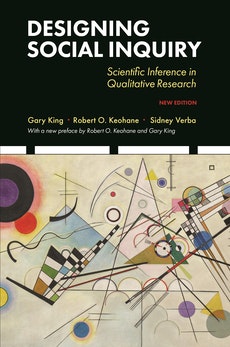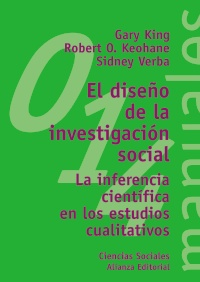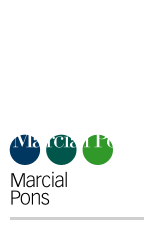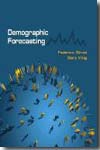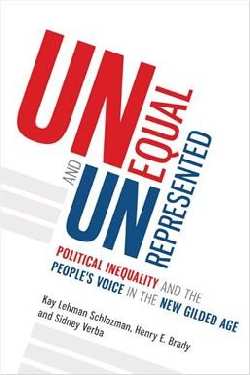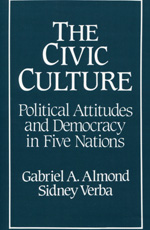Designing social inquiry
scientific inference in qualitative research
- ISBN: 9780691224626
- Editorial: Princeton University Press
- Fecha de la edición: 2021
- Lugar de la edición: Princeton. Estados Unidos de Norteamérica
- Edición número: 2nd ed.
- Encuadernación: Rústica
- Medidas: 23 cm
- Nº Pág.: 243
- Idiomas: Inglés

Designing Social Inquiry presents a unified approach to qualitative and quantitative research in political science, showing how the same logic of inference underlies both. This stimulating book discusses issues related to framing research questions, measuring the accuracy of data and the uncertainty of empirical inferences, discovering causal effects, and getting the most out of qualitative research. It addresses topics such as interpretation and inference, comparative case studies, constructing causal theories, dependent and explanatory variables, the limits of random selection, selection bias, and errors in measurement. The book only uses mathematical notation to clarify concepts, and assumes no prior knowledge of mathematics or statistics.
Featuring a new preface by Robert O. Keohane and Gary King, this edition makes an influential work available to new generations of qualitative researchers in the social sciences.
1 The Science in Social Science 1
1.1 Introduction 1
1.1.1 Two Styles of Research, One Logic of Inference 1
1.1.2 Defining Scientific Research in the Social Sciences 5
1.1.3 Science and Complexity 8
1.2 Major Components of Research Design 11
1.2.1 Improving Research Questions 12
1.2.2 Improving Theory 18
1.2.3 Improving Data Quality 22
1.2.4 Improving the Use of Existing Data 26
1.3 Themes of This Volume 27
1.3.1 Using Observable Implications to Connect
Theory and Data 28
1.3.2 Maximizing Leverage 28
1.3.3 Reporting Uncertainty 31
1.3.4 Thinking like a Social Scientist: Skepticism
and Rival Hypotheses 31
2 Descriptive Inference 33
2.1 General Knowledge and Particular Facts 34
2.1.1 “Interpretation” and Inference 36
2.1.2 “Uniqueness,” Complexity, and Simplification 41
2.1.3 Comparative Case Studies 43
2.2 Inference: The Scientific Purpose of Data Collection 45
2.3 Formal Models of Qualitative Research 48
2.4 A Formal Model of Data Collection 50
2.5 Summarizing Historical Detail 52
2.6 Descriptive Inference 54
2.7 Criteria for Judging Descriptive Inferences 62
2.7.1 Unbiased Inferences 63
2.7.2 Efficiency 65
3 Causality and Causal Inference 73
3.1 Defining Causality 74
3.1.1 The Definition and a Quantitative Example 75
3.1.2 A Qualitative Example 80
3.2 Clarifying Alternative Definitions of Causality 83
3.2.1 “Causal Mechanisms” 83
3.2.2 “Multiple Causality” 85
3.2.3 “Symmetric” and “Asymmetric” Causality 88
3.3 Assumptions Required for Estimating Causal Effects 89
3.3.1 Unit Homogeneity 90
3.3.2 Conditional Independence 92
3.4 Criteria for Judging Causal Inferences 95
3.5 Rules for Constructing Causal Theories 96
3.5.1 Rule 1: Construct Falsifiable Theories 98
3.5.2 Rule 2: Build Theories That Are Internally Consistent 103
3.5.3 Rule 3: Select Dependent Variables Carefully 105
3.5.4 Rule 4: Maximize Concreteness 107
3.5.5 Rule 5: State Theories in as Encompassing Ways
as Feasible 111
4 Determining What to Observe 113
4.1 Indeterminate Research Designs 116
4.1.1 More Inferences than Observations 117
4.1.2 Multicollinearity 120
4.2 The Limits of Random Selection 122
4.3 Selection Bias 125
4.3.1 Selection on the Dependent Variable 126
4.3.2 Selection on an Explanatory Variable 135
4.3.3 Other Types of Selection Bias 136
4.4 Intentional Selection of Observations 137
4.4.1 Selecting Observations on the Explanatory
Variable 138
4.4.2 Selecting a Range of Values of the Dependent
Variable 139
4.4.3 Selecting Observations on Both Explanatory and
Dependent Variables 140
4.4.4 Selecting Observations So the Key Causal Variable
Is Constant 144
4.4.5 Selecting Observations So the Dependent Variable
Is Constant 145
4.5 Concluding Remarks 147
5 Understanding What to Avoid 148
5.1 Measurement Error 149
5.1.1 Systematic Measurement Error 154
5.1.2 Nonsystematic Measurement Error 156
5.2 Excluding Relevant Variables: Bias 166
5.2.1 Gauging the Bias from Omitted Variables 166
5.2.2 Examples of Omitted Variable Bias 174
5.3 Including Irrelevant Variables: Inefficiency 180
5.4 Endogeneity 183
5.4.1 Correcting Biased Inferences 185
5.4.2 Parsing the Dependent Variable 186
5.4.3 Transforming Endogeneity into an Omitted
Variable Problem 187
5.4.4 Selecting Observations to Avoid Endogeneity 188
5.4.5 Parsing the Explanatory Variable 191
5.5 Assigning Values of the Explanatory Variable 194
5.6 Controlling the Research Situation 196
5.7 Concluding Remarks 204
6 Increasing the Number of Observations 205
6.1 Single-Observation Designs for Causal Inference 206
6.1.1 “Crucial” Case Studies 206
6.1.2 Reasoning by Analogy 209
6.2 How Many Observations Are Enough? 210
6.3 Making Many Observations from Few 215
6.3.1 Same Measures, New Units 217
6.3.2 Same Units, New Measures 221
6.3.3 New Measures, New Units 222
6.4 Concluding Remarks 227

